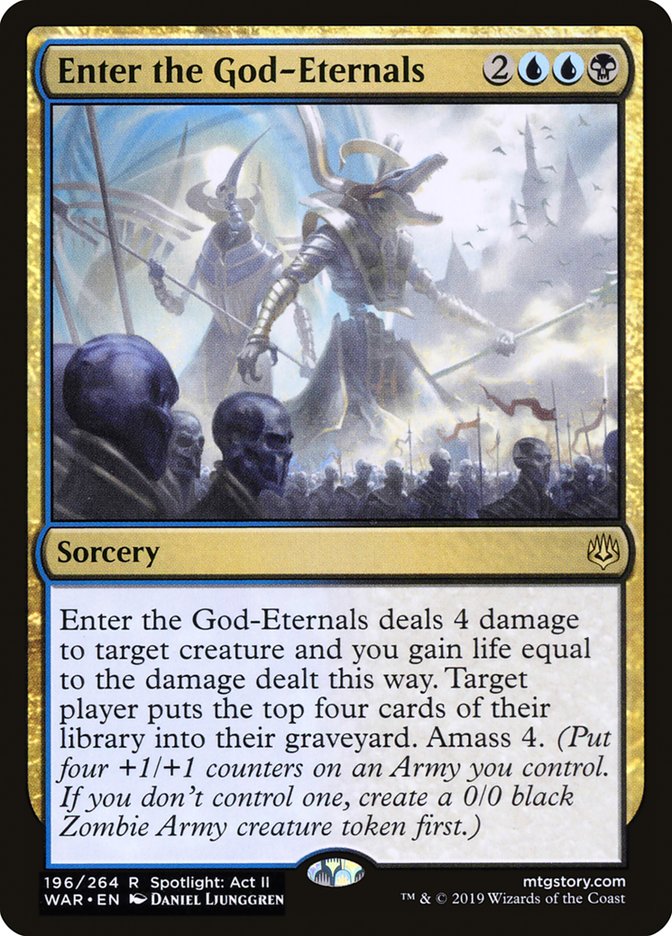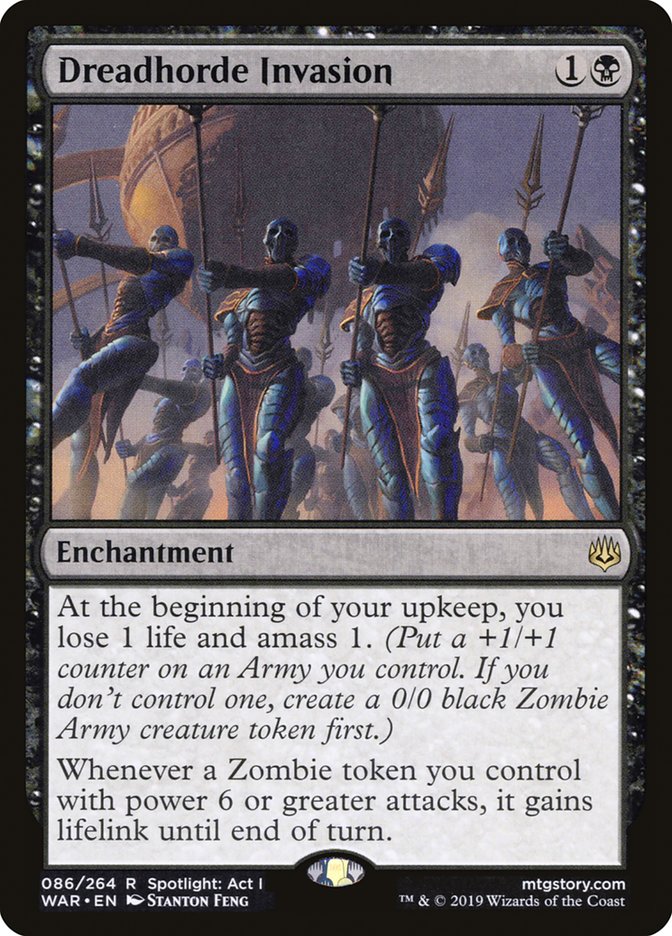Finally, War of the Spark is here in its entirety! It’s time to get to work figuring out exactly what we want to be playing early in the format. But how? In a world with infinite possibilities, how do we even start trimming down our options? I hold on to two mantras in the early weeks of Standard.
First, I stay proactive and I stay powerful. Note: this does not mean the same thing as the oft-repeated “Play aggro Week 1.” Instead, it means keeping card quality extremely high, not getting cute with flex slots, and having a clear gameplan. Decks that must have their 75 balanced on the classic midrange knife’s edge are too hard to nail Week 1. Again, this doesn’t mean “Don’t play midrange.” Think of it more like “If you’re going to play Sultai, have Carnage Tyrant as your finisher, not Doom Whisperer.” Week 1 is about overkill.
Second, I make a broad but logical format assumption, and I let it be my starting tentpole. It can be challenging to find a logical assumption about a format that doesn’t yet exist. Sometimes it can be derived from the discourse surrounding the set. If everyone is writing and tweeting about the same cards, you know they will be out in full force. Sometimes a mechanic is so absurd that it just demands exploitation. For War of the Spark, though, it feels like our attention is being pulled in 10,000 directions. How can we proceed when half the set seems to hold a world of promise?
The answer, as always, lies in comedic fantasy fiction. “If you do not know where you come from, then you don’t know where you are, and if you don’t know where you are, then you don’t know where you’re going. And if you don’t know where you’re going, you’re probably going wrong.” I’m not 100% sure Sir Terry Pratchett was talking about Lucas Faley’s Mono-Red list when he wrote that line, but I promise it applies.
Creatures (20)
- 4 Fanatical Firebrand
- 4 Ghitu Lavarunner
- 4 Goblin Chainwhirler
- 4 Viashino Pyromancer
- 4 Runaway Steam-Kin
Lands (18)
- 18 Mountain
Spells (22)
Sideboard

1) I would like more twitter followers.
2) This deck is still busted.@arenadecklists pic.twitter.com/qKHxHZIaTV— lewk (@lucasfaley) April 9, 2019
Lucas recently qualified for the Mythic Invitational by ranking as one of the Top 8 players on all of Arena, and he reached that mark almost exclusively playing Mono-Red. He knows this archetype cold. Despite this fact, I mostly dismissed this deck. Mono-Red was an early-format problem, and it had been solved authoritatively in the best-of-three realm. Then Lucas started talking about his win percentage over in The GAM Podcast Discord. The numbers he was reporting back were simply unrealistic in recent Standard metagames. You don’t see 80% win rates these days. Then other members of our Discord started picking up the deck as well. @KanyeBest was one of them.
RANK ONE BABY! Shouts to @lucasfaley for the list, @JRolfMTG for telling me the only play was to go for 1, and everyone in various discords who has helped me get good at this game.
cc: @arenadecklists one last time – I suppose knowing what deck hit rank 1 is pretty dece. pic.twitter.com/TzDrsFhb1n
— Kanye Best (@KanyeBestMTG) April 16, 2019
Again, for a period, KanyeBest was reporting near-80% win rates against the best competition Arena’s Mythic ranks had to offer. A few days later, along comes Martin Fernandez:
TOP #1 IN MY FIRST SEASON PLAYING MTG ARENA !! THIS #LEWKDECKWINS IS INSANE !!! 88% Winrate (16-2 only lose 2 mirror with bad hands) @lucasfaley @TenaciousMTG @KanyeBestMTG !! @arenadecklists #LDW pic.twitter.com/D4qFuA1qNV
— Martín Fernández (@gincamparirosso) April 22, 2019
If relevant Standard was being played right now, this deck would be all anyone was talking about. Since we’re in the lull between sets, the deck continues to fly under the radar. I don’t expect that to continue when new Standard begins on Arena this Thursday. While Mono-Red hasn’t really picked up any significant new tools, I still believe you must start testing new archetypes against this deck. If a deck can’t hang against Lucas’s Mono-Red list, then it’s not a good idea to play it Week 1. Period.
Thankfully, it’s not all doom and gloom, because some of my favorite cards in War of the Spark are ready to answer the challenge of an aggressive red deck.
With appropriate deckbuilding concessions, the ability for Dreadhorde Invasion to make a 6/6 lifelinking Zombie Army can function as the breakpoint in a matchup where Mono-Red was previously able to dominate the early- and late-game. Add in the fact Dimir decks finally have a palatable out to a resolved Experimental Frenzy, and we can start looking at a new archetype that might have some legs against the entirety of the field.
Creatures (6)
Planeswalkers (2)
Lands (25)
Spells (27)
- 2 Negate
- 3 Vraska's Contempt
- 1 Moment of Craving
- 2 Cast Down
- 4 Thought Erasure
- 2 Chemister's Insight
- 2 Discovery
- 1 Cry of the Carnarium
- 4 Dreadhorde Invasion
- 3 Enter the God-Eternals
- 2 Commence the Endgame
- 1 Finale of Eternity
Sideboard

The lifegain has arrived in spades. It’s crazy how dramatic the impact of Enter the God-Eternals is against aggressive strategies. Gerry Thompson wrote about the card at length, so I won’t rehash the same exaltations, but this card’s presence can swing a matchup by double-digit percentage points.
Presently, I am placing a premium on Augur of Bolas’s defensive capability, but it’s pretty clear that at some point maindeck Thief of Sanity becomes the call again. If this can’t hold pace with the aggressive decks, there are always more dials to turn, as Fungal Infection and increased numbers on Moment of Craving remain on the table. I am extremely curious if there will be enough downtime to preemptively invest in Blast Zone so it’s ready to answer Experimental Frenzy off the top in the late-game. Obviously, answering on Turns 4 and 5 is not realistic, but in my experience, that’s not how the matchup goes, and it’s the Frenzy coming down on Turns 7 or 8 that really spells doom. In those instances, Blasting Zone might be just what we need, and if not, we still make it difficult for a group of one- and two-drops to get wider than our defenses. I also really like the addition of God-Eternal Kefnet for this matchup, as the 4/5 body is awkward for Mono-Red to deal with, even in sideboard configurations.
God forbid you ever reveal Enter the God-Eternals with its ability…
As far as matchups against the slower end of the spectrum, Dreadhorde Invasion still has to prove itself as the sticky threat we need against Esper Control. I have concerns, but regardless, we’ll have Thief of Sanity to lean on in sideboard games, and the instant-speed uncounterable threat provided by Commence the Endgame changes a lot of play patterns. Against Simic Nexus, we’ll have to get our Blasting Zones on four as quickly as possible and hope that our Negates are around when we need them, but this is going to be a scary matchup until we get some sideboard help.
Speaking of Simic Nexus, it fell dramatically from a position of contending for the best deck in the format to being absolutely farmed by Mono-Red Aggro. Fear not, Simic friends, for help has arrived.
Creatures (4)
Planeswalkers (1)
Lands (25)
Spells (30)

I don’t think I realized just how critical Augur of Bolas would be in my deckbuilding when it was first previewed, but much of its omnipresence is a response to my guiding assumption. If Mono-Red is everywhere, moves like this are what’s needed to push the format back to equilibrium. We can’t play the full playset of Augurs, since running 23 instants and sorceries is about as low as I want to go. In the past, the Mono-Red Aggro matchup left you routinely feeling exactly one turn too slow, and I think Augur of Bolas can ease some of that pain. Our other main War of the Spark addition is Tamiyo, Collector of Tales, which has upside over being a redundant copy of your Game 1 win condition (i.e. the second Hydroid Krasis).
I’ve seen some Simic Nexus pilots express a lot of fear of a new planeswalker lurking in War of the Spark.
The good news is that there’s almost no chance this card proves good enough for maindeck play. In most matchups 75% of the card text is blank, and against the other 25% is a sorcery-speed bounce spell. That’s not going to cut it against most Standard decks. And while it is very good against our Game 1 configuration, it gets much worse in sideboard games when our threats become diversified and Kraul Harpooner is around to pressure Teferi. Don’t make a mountain out of a molehill. Simic Nexus has plenty of counterplay options.
My final front runner for Week 1 of War of the Spark Standard is a bit of a reversion, made possible by a fearsome new War of the Spark planeswalker.
Creatures (21)
- 4 Llanowar Elves
- 1 Carnage Tyrant
- 4 Wildgrowth Walker
- 4 Merfolk Branchwalker
- 4 Jadelight Ranger
- 2 Ravenous Chupacabra
- 1 Golgari Findbroker
- 1 Incubation Druid
Planeswalkers (7)
Lands (24)
Spells (8)

All hail the new queen of midrange. Freed from the tyranny of the Hydroid Krasis arms race, we return to a much less damaging manabase and get our points back against Mono-Red. While Liliana, Dreadhorde General lacks the uncounterability of Hydroid Krasis in control matchups, we can make some sideboard concessions to Teferi and friends. Maybe this is too cute and we’re just supposed to combine Liliana with Krasis for even more haymakers, but I want to find out what Liliana is capable of. What better way to do so than by forcing it to carry the entirety of the late-game load? I considered a Karn’s Bastion in the Blast Zone slot, but it just felt like a win-more. With twenty permanents that carry counters, though, maybe it will eventually prove its worth as a faux Gavony Township.
This is just the tip of the iceberg when it comes to War of the Spark Standard, and I think you could come to a whole new set of starting decks if you reject my initial Mono-Red-based framework. Based on how well Lucas’s deck continues to perform, I’m comfortable starting here, though. We’ll see what next week brings after I’ve had a few days on the Standard ladder!




